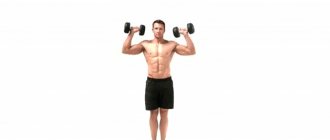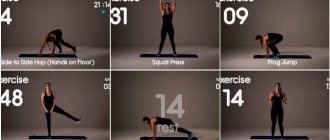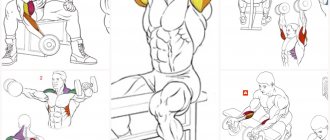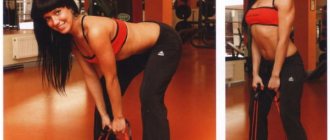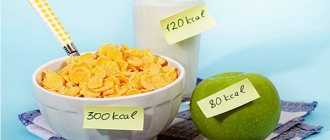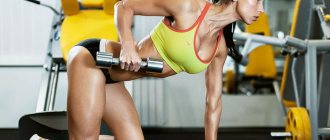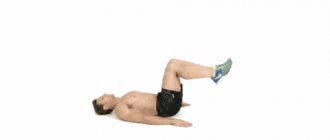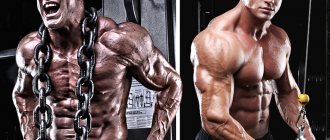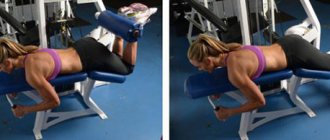Muscle gain - this is a complex adaptive anabolic process that can occur both due to hypertrophy of muscle fibers and due to their hyperplasia, but in order for this process not to hit the “genetic ceiling”, in addition to muscle qualities, the athlete also needs to develop non-muscle ones systems. The muscle mass gain program is a training plan for the year, consisting of micro and macro periods, each of which pursues its own objectives, while at the same time allowing the recovery of those body systems that were overloaded in the previous period, which ultimately allows the athlete to gain clean weight over a long period of time without hindrance. muscle mass.
A program for gaining muscle mass involves two key points: firstly, the athlete’s physical and moral readiness to use this program and, secondly, macro-periodization of the training process and nutrition. It is important to take into account the individual characteristics of the athlete, such as samatotype, on which the diet will depend, muscle which the prevailing type of load will depend, as well as metabolic rate, which partly depends on the samatotype, but does not directly correlate with it , therefore, we will highlight it as a separate factor that determines the duration of each macroperiod. From all that has been said above, it follows that using this training program, the athlete will not be able to “take more and throw further,” but will have to keep a training diary, analyze the results and adjust the program for himself.
Terms and rules for using the program
Physical – we put these conditions in first place, since they determine not only the possibility of using a muscle mass gain program from the point of view of expediency, but also the possibility of using it from a safety point of view. If an athlete is not physically ready, he will most likely get injured, overtrain and be forced to temporarily stop training altogether. At the same time, the physical conditions are very simple: training experience of at least a year, strength indicators for 8 repetitions in the bench press - 100% of your own weight, in squats 150% of your own weight and in the deadlift of your own weight.
Moral is, first of all, the athlete’s willingness to strictly follow all the requirements of the program, as well as the availability of such an opportunity. If an athlete is forced to work 12 hours a day, sleep less than 8 hours, in general, if training is not a priority at the moment, then it is better to use simpler training systems. The essence is the same! If an athlete does not have time to recover, the consequence will be injuries and overtraining; if he does not have time to visit the gym, then the consequence will be a lack of results. On the other hand, a bad workout is better than no workout! Just weigh your options wisely and decide how much you are willing to put sports first, because this program will require it of you.
Macroperiodization is a key aspect of the program, allowing you to gain pure muscle mass. At one of his seminars, George Farah said: “If you can’t show off your abs in the off-season, then you’re not a bodybuilder!” Many were skeptical, but Kai Greene's results have improved dramatically since working with George Farah, most notably the quality of his muscle mass. The idea is anabolic resistance, which is directly related to the amount of subcutaneous fat. The more fat in the body, the less the anabolic effect of training! This process looks like this: more fat -> higher insulin resistance -> endoplasmic reticulum stress -> muscle and leptin resistance -> lack of muscle growth and increased body fat.
During weight gain, the athlete, in any case, is forced to consume calories in excess, since otherwise the body will not have the resources to synthesize new contractile proteins. What to do? Alternate periods of gaining muscle mass and “cutting”!
But, since there are two fundamentally different methods of gaining muscle mass, namely hypertrophy and hyperplasia, the athlete will work on hypertrophy of muscle fibers for the first 6 months, and on hyperplasia for the next 6 months. Therefore, for the first three months the athlete works in a strength mode, then 3 months of classical mass-gaining training aimed at hypertrophy, after which the athlete “dries out” for one and a half months using a carbohydrate-free diet, then two months of pumping, one and a half months of “drying” and another 1 month of pumping.
Burning fat on the treadmill
Many girls exaggerate the importance of treadmills. Indeed, they can burn excess weight and calories, but it will be negligible compared to proper nutrition for weight loss. For example, a chocolate bar contains about 550 calories, exactly the same amount you will spend in 2 hours on a treadmill, and besides, it’s not a fact that these calories went through fat and not through carbohydrates, about 50 to 50.
Burning fat on the treadmill
Therefore, it would be much more correct to eat right and keep your muscles toned, so that excess carbohydrates are stored as glycogen in the muscles, and not as fat.
To all that has been said, we can add that you should not get hung up on any particular exercises; introduce variety into your training program by choosing the necessary exercise for the desired muscle groups.
Now you understand the principle of building training programs for girls, if anyone has any difficulties, please contact us through the feedback form, and they will be happy to answer all your questions about fitness and bodybuilding.
If you find an error, please select a piece of text and press Ctrl+Enter.
Individualization of the program for gaining muscle mass
The self-type is one of the main criteria for building a nutritional system during muscle mass gain and strength development. This parameter, of course, is important when choosing a diet for “cutting”, but in this program it is necessary to “dry” on a carbohydrate-free diet, since after 6 weeks of carbohydrate-free diet the body manages to adapt to using proteins and fats as energy, therefore, when the athlete starts again If you eat carbohydrates, then supercompensation occurs, causing an anabolic effect.
There are three self-types in total: ectomorphs, mesomorphs and endomorphs, which you can read more about here . The diet will be approximately the same in any case, but the athlete needs to adjust the daily caloric intake so that the athlete has time to recover between workouts, while at the same time reducing fat gain to a minimum. also depends on the self-type , since You can read in detail about how to eat while gaining muscle mass here , and about how to enhance the effect of a mass-gaining diet here .
Muscle composition is a genetically determined parameter that determines the number of muscle cells, as well as the ratio of fast and slow muscle fibers in the body. It is important to note that fast muscle fibers may predominate in some muscles of the same athlete, while slow muscle fibers may predominate in other muscles. From a practical point of view, bodybuilders are interested in this question in the sense that slow muscle fibers need to be trained with volume training, and fast muscle fibers with intense training. Therefore, since a muscle-building program offers athletes a repetition range of 6 to 12, each athlete should select the number of repetitions and speed of each repetition that best stimulates muscle hypertrophy.
Unfortunately, you can only understand what type of training is best for you through experimentation, trying to train your muscles using explosive techniques, slowly pumping them up and, observing your results, choose what is best for you. The first signal can be the results of the strength period, since strength indicators are mainly responsible for fast muscle fibers. But it should be noted that strength indicators are also influenced by the bone constitution, that is, the length of the arms, legs and body, so it is impossible to draw unambiguous conclusions based on strength indicators! The required time under load to train fast muscle fibers is 15-25 seconds, slow muscle fibers – up to 50 seconds.
Recovery after training
Beginners are mistaken in believing that the key to muscle growth lies only in proper training. In fact, to create the body of your dreams, you will need to follow a routine and get enough rest. Remember - muscles do not grow in the gym, but in breaks between classes, during the recovery process.
The optimal number of workouts per week for gaining weight is 3; if the body does not have time to renew its strength, it can be reduced to 2. It is important to know that large muscle groups recover in approximately 72 hours, small ones – 48. But keep in mind that each person is individual.
The goal of training in the gym is to cause microtrauma to the muscles. That's why volumes only increase during rest - muscle fibers gradually heal, recover, become larger and stronger.
How to properly recover after training
Don't forget about your sleep schedule: proper training is good, but your sleep schedule is no less important. Therefore, you need to ensure that you get adequate sleep. Lack of sleep inhibits muscle growth.
Training plan for gaining muscle mass
Strength program
Monday – I training session Barbell squats (50%) – 5 sets of 5 reps Power press (75-100%) – 5 sets of 5 reps Superset (2 exercises): French bench press – 5 sets of 10 reps Dumbbell flyes – 5 sets of 10 reps
Wednesday – Workout II Reverse hyperextension – 3 sets of 10 reps Deadlifts (75-100%) – 5 sets of 5 reps Wide grip pull-ups – 5 sets max Superset (2 exercises): Leg curls – 3 sets of 12 reps Raises socks – 3 sets of 20 reps
Saturday – III workout Barbell squats (75-100%) – 5 sets of 5 reps Romanian deadlift – 3 sets of 12 reps Power press (50%) – 5 sets of 5 reps Arnold press – 3 sets of 10 reps Hammer curls – 3 sets of 12 reps
Notes* rest between approaches in exercises with 75-100% load - 3-5 minutes, in other exercises rest 60-90 seconds. The load alternates only in the main exercises; one week the athlete performs exercises with 100% load, the second with 75%. The duration of the strength program is 3 months.
Mass program
Monday - chest and anterior delts Squats with a barbell on the shoulders (50%) - 4 sets of 12 reps Bench press (75-100%) - 4 sets of 6-12 reps Angle dumbbell press (75-100%) - 4 sets 8-12 reps Superset (2 exercises): Arnold press – 4 sets of 8-12 reps Dumbbell front raises – 4 sets of 8-12 reps Hanging leg curls – 3 sets max
Wednesday – latissimus dorsi and deltoids Bent-over barbell rows (75-100%) – 4 sets of 6-12 reps Wide-grip pull-ups – 4 sets to the maximum Lumbar rows – 4 sets of 8-12 reps Shrugs – 3 sets of 20 reps Superset (2 exercises): Barbell rows to the chin – 4 sets of 8-12 reps Crossover swings – 4 sets of 8-12 reps Hyperextension – 4 sets of 15 reps
Friday – legs and chest Barbell squats (75-100%) – 4 sets of 6-12 reps Romanian deadlift (75-100%) – 4 sets of 8-12 reps Triset (3 exercises): Leg curls – 3 sets of 12 reps Leg extensions – 3 sets of 12 reps Calf raises – 3 sets of 20 reps Bench press (50%) – 4 sets of 12 reps Dumbbell flyes – 4 sets of 12 reps Reverse hyperextensions – 3 sets of 15 reps
Notes* Rest between approaches is 60 seconds, the load alternates in exercises where the percentages are 75-100, respectively, in one week the athlete trains with 75% of the working weight, and in the second with 100%. The duration of the program is 3 months.
Drying program
Monday – chest and arms Bench press – 4 sets of 12 reps Bench press – 4 sets of 12 reps Dips – 4 sets of 12 reps Superset (2 exercises): Bicep curls – 5 sets of 12 reps French press standing – 5 sets of 12 reps Hanging leg raises – 5 sets max Cable crunches – 5 sets of 30 reps
Wednesday - latissimus dorsi and deltoids Bent- over barbell rows - 4 sets of 12 reps Lat rows - 4 sets of 12 reps Lat rows - 4 sets of 12 reps Reverse grip lat rows - 4 sets of 12 reps Superset (2 exercises) ): Barbell rows to the chin – 5 sets of 12 reps Dumbbell swings to the sides – 5 sets of 12 reps
Friday – legs Barbell squats – 3 sets of 20 reps Leg press – 4 sets of 15 reps Romanian deadlift – 5 sets of 12 reps Superset (2 exercises): Leg curls – 3 sets of 15 reps Leg extensions – 3 sets of 15 reps Superset (2 exercises): Calf press – 3 sets of 20 reps Calf raises – 3 sets of 20 reps
Notes* rest between sets for 30 seconds, with the exception of squats, between which you need to rest for a minute. The load does not alternate, there is no need to progress it either, it is important to keep the weights as close as possible to the original values. The duration of the program is one and a half months.
